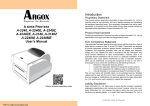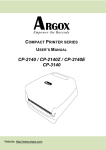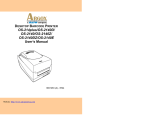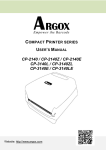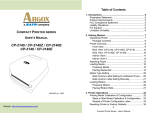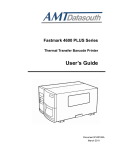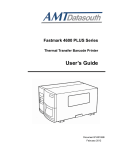Download Argox A-2240E Specifications
Transcript
Proprietary Statement A-2240, A-2240E Desktop Barcode Printer This manual contains proprietary information of Argox Information Co., Ltd. It is intended solely for the information and use of parties operating and maintaining the equipment described herein. Such proprietary information may not be used, reproduced, or disclosed to any other parties for any other purpose without the expressed written permission of Argox Information Co., Ltd. Product Improvements Continuous improvement of products is a policy of Argox Information Co., Ltd. All specifications and signs are subject to change without notice. FCC Compliance Statement This equipment has been tested and found to comply with the limits for a Class A digital device, pursuant to Part 15 of the FCC Rules. These limits are designed to provide reasonable protection against harmful interference in a residential installation. This equipment generates, uses, and can radiate radio frequency energy and, if not installed and used in accordance with the instructions, may cause harmful interference to radio communications. However, there is no guarantee that the interference will not occur in a particular installation. If this equipment does cause harmful interference to radio or television reception, which can be determined by turning the equipment off and on, the user is encouraged to try to correct the interference by the following measures: Reorient or relocate the receiving antenna. Increase the separation between the equipment and the receiver. Connect the equipment into a different outlet on a different circuit. Consult the dealer or an experience Radio/TV technician for help. This unit was tested with shielded cables on the peripheral devices. Shielded cables must be used with the unit to insure compliance. The user is cautioned that any changes or modifications not expressly approved by Argox Information Co., Ltd. could void the user’s authority to operate the equipment. CE Statement of Conformity User’s Manual This products is herewith confirmed to comply with the requirements set out in the Council Directive on the Approximation of the laws of the Member States relating to Electromagnetic Compatibility Directive (2004/108/EC). For the evaluation regarding EMC, the following standard was applied: RFI Emission: EN 55022: 2006 + A1: 2007 Class A EN 61000-3-2: 2006 2 EN 61000-3-3: 1995+A1: 2001+A2: 2005 Table of Contents Immunity: EN 55024: 1998+A1: 2001+A2: 2003 Getting Started ............................................................................6 Unpacking ...............................................................................6 Package Contents ............................................................................ 7 Connecting the Power Supply .................................................8 Getting to Know Your Printer.....................................................10 Parts and Features................................................................10 Controls and Indicators .........................................................12 Loading Ribbon and Media .......................................................14 Loading a Ribbon..................................................................14 Loading Media ......................................................................19 Standard Mode................................................................................ 19 Peel Off Mode ................................................................................. 24 Cutter Mode..................................................................................... 29 Configuration and Configuration................................................37 Performing Calibration and a Configuration Report ...............37 Retuning to Factory Default Settings .....................................38 Computer Connections .............................................................39 USB Interface Requirements.................................................39 Serial (RS-232) Interface Requirements................................40 Serial Cabling Requirements.................................................40 Ethernet 10/100 Internal Printer Server Option......................42 Communicating with the Printer ................................................44 Installing the Printer Driver (Argox Seagull Driver) ................45 Driver for Plug and Play (USB only) ......................................51 Driver for WIN Vista (USB only) ............................................56 Troubleshooting......................................................................62 LED Diagnosis ......................................................................62 Miscellaneous .......................................................................65 Recovery...............................................................................66 Caring for Your Printer...............................................................67 Cleaning................................................................................67 Media Sensor .................................................................................. 67 Thermal Print Head......................................................................... 67 Replacing Thermal Print Head ..............................................70 Liability Disclaimer Argox Information Co., Ltd. takes steps to assure that the company’s published engineering specifications and manuals are correct; however, errors do occur. Argox Information Co., Ltd. reserves the right to correct any such errors and disclaims any resulting liability. In no event shall Argox Information Co., Ltd. or anyone else involved in the creation, production, or delivery of the accompanying product (including hardware and software) be liable for any damages whatsoever (including, without limitation, damages for loss of business profits, business interruption, loss of business information, or other pecuniary loss) arising out of the use of or the results of use of or inability to use such product, even if Argox Information Co., Ltd. has been advised of the possibility of such damages. 3 4 Important notice during TPH replacement................................. 72 Technical Reference ................................................................. 73 General Specifications.......................................................... 73 Fonts, Bar Codes and Graphics Specification....................... 76 Printer Programming Language A, PPLA.....................................76 Printer Programming Language B, PPLB.....................................77 Printer Programming Language Z, PPLZ .....................................78 Interface Specifications......................................................... 80 USB Interface.................................................................................80 Serial................................................................................................81 Ethernet...........................................................................................82 Connection with host.......................................................................83 Appendix I - Installing the Extension Card ........................... 85 Getting Started Congratulations on choosing the Argox Amigo Series desktop barcode printer. This user’s manual will help you get to know your new printer. The manual includes a guide to operating the printer as well as related information on troubleshooting, maintenance, and technical reference. Illustrations are provided to help you quickly become familiar with the printer. Unpacking After receiving your printer, please check for possible shipping damage: 1. Inspect the outside of both the box and the printer for possible damage. 2. Open the top cover of the printer to see if the media compartments are in order. Note: If damage has occurred, contact your shipping company immediately to file a claim. 5 6 Printer Connecting the Power Supply Sample Media Ribbon Connect the power supply as below. WARNING: 1. do not operate the printer and power supply in an area where they might get wet. 1. Make sure the power switch is in the "O" position. 2. Insert the barrel connector of the power supply into the power jack on the back of the printer. 3. Insert the separate power cord into the power supply. 4. Plug the other end of the cord into an AC electrical outlet. Quick Guide Power Supply Power Cord CD Rom Disk Package Contents Printer Quick Guide CD Rom Disk Power Supply Power Cord Ribbon Sample Media Power Cord 7 8 Getting to Know Your Printer The illustrations that follow describe the printer’s parts, features, controls, and indicators. Parts and Features Ready Indicator Top Cover Power Indicator Power Cord Feed Button 9 Power Switch 10 Controls and Indicators The printer’s controls and indicators are shown in the diagram below. The following table explains control and indicator functions. Media Hanger Release Levers Ready Indicator Top Cover Power Indicator Ribbon Pick-up Holder Ribbon Supply Holder Thermal Printhead Feed Button 11 Power Switch 12 Control / Indicator Function On: turns on normal operation Power Switch Off: turns off power Note: Turn power off before connecting or disconnecting cables Green light shows printer power on Light off shows printer power off Blinking light indicates error has occurred Power Indicator Ready Indicator Green shows printer is ready to operate Blinking light indicates printer is paused or receiving data Seagull driver status monitor Press to advance the label media to the first printing position Press to take the printer out of "pause" Press and hold while turning on the power to print out a configuration profile Feed Button 13 Loading Ribbon and Media This section describes how to load ribbon and media in the Amigo Series printers. Loading a Ribbon Note: This section does not apply to direct thermal printing. 1. Lift the top cover to expose the media compartment. 2. Unlatch the print head module by pushing the two purple release levers on the sides toward the rear. 3. Turn over the print head module to expose the ribbon supply holder. 14 4. Unwrap the ribbon roll pack and separate the ribbon roll and the bare core. 5. Attach the edge of the ribbon on the bare core and wind it a little bit onto the core. 6. Insert the ribbon roll into the supply holder. (First snap in the right side and then the left side.) Media Compartment Release Lever Ribbon Roll Print Head Module Ribbon Supply Holder Bare Core 15 16 7. Turn back the print head module and then insert the bare core into the pick-up holder. (First snap in the right side, then the lift side.) 8. Turn the wheel of the print head module to ensure the ribbon is tightly wound. 9. Press down the print head module on both sides firmly till you hear a snap. Wheel Print Head Module 17 18 Loading Media The Amigo Series printers offer three different loading modes: standard, peel-off, or with a cutter. 2. Remove the media hanger. 3. Load the media roll onto the hanger. 4. Unlatch the print head module. 5. Open the front cover to allow the labels pass through the slot. Standard mode allows you to collect each label freely. Peel-off mode peels backing material away from the label as it prints. After the label is removed, the next label prints. Cutter mode automatically cuts the label after it prints. Standard Mode 1. Lift the top cover to expose the media compartment. Media Hanger Media Compartment Ribbon Roll Front Cover 19 20 6. Lead the labels through the media guides with the other hand. The media guide can be adjusted centrally to fit with different label widths. 7. Press the print head module down firmly on both sides until you hear a snap. Print Head Module Media Guides 21 22 Peel Off Mode 8. Close the top cover and turn on the printer or press the feed button if the printer is already on. 1. Unscrew the two screws behind the front cover. 2. Remove the front cover. Screw Feed Button 23 24 3. Plug in the dispenser connecter. 4. Mount the dispenser module. 5. Secure the two screws behind the front cover. 6. Lead the labels through the media guides and dispenser. Dispenser Connecter Screws Media Guides Dispenser Module Dispenser 25 26 7. Press down the print head module firmly until you hear a snap. 8. Close the top cover and turn on the printer or press the feed button if the printer is already on. 9. Press the feed button and the label backing paper will come out from the slot under dispenser. Note: The feed button does not make the printer peel. Peeling occurs only when the software is properly set. Feed Button Feed Button Label Backing Paper 27 28 4. Cutter Mode Loose the 2 screws on the printer bottom. Note: For cutter mode you must first install the cutter and cutter baby board to J16 on the main board 1. 2. 3. Turn off the POWER switch. Unscrew the two screws behind the front cover. Remove the front cover. Screw 5. Pull out front side of "Middle Cover" then remove it from "Bottom". 6. Take out "Middle Cover". Screw Front Cover 29 30 7. Remove the whole print head assembly by releasing the 4 screws at its feet. 8. Plug the cutter baby board to J16 on the main board. J16 31 32 12. Plug in the cutter connecter 9. Reattach the print head assembly by securing the 4 screws and pull the front side of "Middle Cover" to put it back. 10. Screw the 2 screws on the printer bottom. 11. Unscrew the screw on the printer module. 12. Remove the tear off bar. 13. Mount Cutter module, and install cutter module completely. Tear Off Bar 33 34 Print Head 14. Lead the label through the media guides and cutter slot. 15. Press down the print head module firmly on both sides until you hear a snap. Note: The feed button does not make the printer cut. Cutting occurs only when the software is properly set. Feed Button Media Guides 35 36 Configuration and Configuration This section discusses calibration, printing configuration and resetting the printer to factory defaults. Performing Calibration and a Configuration Report 1. Turn off the printer power. 2. Press and hold the feed button while turning on the power, until the printing motor is activated. 3. Calibration is performed while the printer automatically feeds the label stock for a certain length, the printing motor suspends for one second and then prints out a configuration profile. 4. The profile includes firmware version, ROM checksum, RS-232, thermal transfer/direct thermal settings, hardware configuration, and font types. 5. At PPLB emulation, the printer enters character dump mode. To exit from dump mode, press the feed button again. (If you accidentally print the label without exiting from dump mode in advance, you need to turn on the printer or press feed button again to print normally.) Retuning to Factory Default Settings 1. Turn on the printer and wait for 5 or more seconds. 2. Press the "Feed" button for 10 seconds, and the "Ready" indicator and "Power" indicator will go off in order. 3. While two indicators become lit again, release the FEED button. 4. The printer will come back to the factory default settings. Note: Revise the factory default settings that stored in flash, even if turn off the power source cannot be eliminated. Important! You must always carry out calibration when changing media. Failure to do so will result in improper detection by the label sensor. 37 38 Computer Connections Serial (RS-232) Interface Requirements Note: You must insert the power supply’s barrel connector into the power jack on the back of the printer before connecting communication cables. The required cable must have a nine-pin "D" type male connector on one end, which is plugged into the mating serial port located on the back of the printer. The other end of the signal interface cable connects to a serial port on the host computer. This printer comes with a nine-pin Electronics Industries Association (EIA) RS-232 serial data interface, a USB interface and Ethernet option. You must supply the required interface cable for your application. For technical and pin-out information, please refer to the Technical Reference, Interface Specifications in this manual. Serial Cabling Requirements Note: This printer complies with FCC Rules and Regulations, Part 15, for Class A Equipment, for use with fully shielded six-foot data cables. Use of longer cables or unshielded cables may increase radiated emissions above Class A limits. Data cables must be of fully shielded construction and fitted with metal or metalized connector shells. Shielded cables and connectors are required to prevent radiation and reception of electrical noise. USB Interface Requirements To minimize electrical noise pickup in the cable: Keep data cables as short as possible (6 ft or 1.83m recommended). Do not tightly bundle the data cables with power cords. Do not tie the data cables to power wire conduits. The Universal Serial Bus (USB) interface is version 2.0 and 1.1 compliant and provides a full-speed (12Mb/s) interface that is compatible with your existing PC hardware. The USB’s “plug and play” design makes installation easy. Multiple printers can share a single USB port/hub. 39 Notes: Default settings are included in the configuration report. 40 Ethernet 10/100 Internal Printer Server Option This connector is for Ethernet application; it is convenient to use several printers by Ethernet connector at the same time. Notes: When using Ethernet model printer, please wait till the Ready Indicator to stop blinking and then can start to use printer. Power Cord Power Cord 41 42 Ethernet Status/Activity Indicators Communicating with the Printer LED Status Both Off Green LED Amber LED Description No Ethernet link detected Speed LED On: 100 Mbps link Off: l0 Mbps link Link/Activity LED On: link up Off: link down Flash: activity The bundled printer driver can be applied to all applications under Windows 2000/2003/Windows XP and Windows Vista and support 32/64 bits version. With this driver you can run any popular Windows software applications such as MS-Word and print out to this printer. Green LED Amber LED 43 44 Installing the Printer Driver (Argox Seagull Driver) 4. Click "Finish". 1. Double click the driver file (Argox Seagull driver) to execute the installation. 2. Windows Printer Driver…..Select I accept and Click "Next" 5. Select Install printer drivers and Click "Next" 3. Write down the Installation Directory (for example: C:'Seagull) and click "Next". 45 46 6. Select a driver for your printer and click "Next". 7. Select model & emulation: A-2240 PPLB 47 8. 9. Select the port of the printer and click "Next" Enter Printer name (i.e. Argox A-2240 PPLB) and select "do not share this printer”, and Click "Next" 48 10. Checking all the data on the showing screen, if data corrected, click "Finish" 12. After the installation is complete click " Close" 11. After the related files have been copied to your system, click "Finish" 49 50 Driver for Plug and Play (USB only) 1. Extract the PrinterDriver.exe to the fixed route. (“C:\Seagull) 2. Connect the label printer to a computer with a USB cable. 3. Turn on the printer’s power and the system detects the device automatically. 4. Select “Install from a list or specific location (Advanced)”, click “Next”. 51 5. Select “Search for the best driver in these locations” and choose “Include this location in the search”. Input the location of the printer driver, click “Next”. 52 6. Select “Continue Anyway”. 53 7. Click “Finish”. 54 Driver for WIN Vista (USB only) 8. The Argox A-2240E PPLB printer is added in “Printers and Faxes”. 9. Reboot the system. 10. The system assigns the USB port for A-2240E PPLB printer. 55 1. Extract the PrinterDriver.exe to the fixed route. (“C:\Seagull) 2. Connect the label printer to a computer with a USB cable. 3. Turn on the printer’s power and the system detects the device automatically. 4. Select “Locate and install driver software (recommended)”. 5. Pop the window “User access control” and click “ Continue” 56 6. Select “I don’t have the disk. Show me the other options.” 57 7. Select “Browse my computer for driver software (advanced) “. 58 8. Input the location of printer driver. (“C:\Seagull) 59 9. Select” Install this driver software anyway” 10. The related files start to copy to your system. 60 11. After the installation is complete, click “Close”. Troubleshooting Normally, when the printer is in not working properly, the "Power" LED blinks continuously, and printing and communication between the host and printer stops. LED Diagnosis If the Power and Ready LEDs are blinking, it means you may have a problem. To understand the problem, please check the Power and Ready LEDs and refer to the following solutions: LED Indicators: Power and Ready LEDs blink at the same tempo Power LED Ready LED ON ON OFF OFF Possible Problems Solutions Remarks Miss-detect gap Check the label path If you use a Check the label sensor continuous label roll and run under Windows, select the continuous media. Label stock out Supply the label roll Label stock not Install the label roll installed Label jam Recover the jam 12. Click” Yes” 61 62 LED Indicators: Power and Ready LEDs blink alternately LED Indicators: Only the Ready LED blinks Power LED Ready LED ON OFF OFF ON Power LED Ready LED ON ON ON OFF Possible Problems Solutions Remarks Ribbon out Supply the ribbon roll Not applicable to direct Ribbon jam Recover the jam thermal type. Ribbon sensor error Replace ribbon sensor Possible Problems Solutions Print head too hot Printing will stop until the print head cools to an acceptable printing temperature. When it does, the printer will automatically resume operation. LED Indicators: Only the Power LED blinks Power LED Ready LED ON ON OFF ON Possible Problems Solutions Remarks Serial IO error Check the baud rate Serial interface only Memory full Add the extension RAM(flash memory card) Cutter failed, or jam Check the cutter Occurs only when at cutter installing or setting Recover the jam the cutter Hardware error Call for service 63 64 Remarks Miscellaneous If the host shows "Printer Time out" 1. Check if the communication cable (serial) is connected securely to your serial port on the PC and to the connector on the printer at the other end. 2. Check if the printer power is turned on. If the data has been sent, but there is no output from the printer. Check the active printer driver, and see if Seagull driver for your Windows system and the label printer has been selected. Vertical streaks in the printout usually indicate a dirty or faulty print head. (Refer to the following examples.) Poor printout quality: The ribbon may not be qualified. The media may not be qualified. Adjust the Darkness (heat temperature). Slow down the print speed. Refer to the next chapter and clean the related spare parts. Recovery After correcting problems, simply press the panel button or restart the printer to continue your print jobs. Make sure the LEDs are not blinking and remember to resend your files. Clean the print head. If the problem persists, replace the print head. 65 66 Caring for Your Printer Adhesives and coatings of media can over time transfer onto the printer components along the media path including the thermal print head and media sensor. This build-up can accumulate dust and debris. Failure to clean the print head, media path, and media sensor could result in inadvertent loss off labels, label jams and possible damage to the printer. Note: Turn off the printer before cleaning. Cleaning Clean the following components of the printer using a cotton bud dampened with alcohol. Do not soak the cotton bud excessively. Media Sensor Debris or dirt on the media sensor can cause a miss-read or unstable detection of the label gap. Clean with a cotton bud dampened with alcohol. Thermal Print Head Thermal paper stock and the ribbon release debris on the print head, which degrades printing quality. Clean the print head with methanol or isopropyl alcohol and a cotton bud. Do not touch the heater element with your fingers. Debris or dirt on the roller should be cleaned with alcohol. 67 TPH Cleaning Interval: It’s strongly recommended to regularly clean print heads at least when changing every one ribbon roll (in thermal transfer printing mode), or every one label roll (in direct thermal printing mode). In addition, if printers are operated under critical applications and environments, or it’s found print quality is degraded, please clean print heads more frequently. TPH Cleaning Material: Surface of print head’s heating element is very fragile. To prevent from any possible damage, please use soft cloth or cotton buds with “Ethanol” or “industry alcohol” to clean print head surface. It’s strongly recommended to wear hand gloves during cleaning progress. Do not touch print head surface by bare hands or with any hard equipment. Water or spit should be kept away in case of corrosion on heating elements. TPH Cleaning Direction: When cleaning print head, please always wipe in One-Way Direction - from Left to Right only, or, from Right to Left only, to clean “Heating Line” of print head gently without excessive stress. Do not wipe back and forth, to avoid dust, dirt, or ribbon residue on cleaning cotton would be attached onto print head again. (Please refer to below picture) 68 Replacing Thermal Print Head 1. 2. Turn off the power and wait for both LEDs to go off. Push the print head module and pull it down as shown by the two arrows below. This releases the print head module from the printer chassis. Push Special Caution: Warranty of print heads will be void if print head serial number is removed, altered, defected, or made illegible, under every circumstance. 69 70 3. 4. 5. 6. 7. Loosen the 2 screws(C) and take off COVER-TPH(79) Unplug the 2 print head cables from the connectors on the old TPH-module. Plug the 2 print head cable to the new TPH-module. Screw the COVER-TPH (79). Put the new “Print Head module” onto “Printer Chassis” with the same way, which you released it from “Printer Chassis 71 Important notice during TPH replacement 1. Heater line should NOT be touched by bare hands to prevent any damage caused by ESD or corrosion. 2. Surface of heaters should NOT be hit or scratched by sharp or hard things to prevent any damage by scratch. 3. Residue or contamination should NOT be removed by a cutter to prevent any damage by dent or scratch. 4. Connector side should NOT be touched when cleaning TPH to prevent delaminated solder between FPC and wafer. Ink-jet characters could be erased, if cleaning cloth was touched them on FPC or label. 5. Heater surface should be free from any condensation. 6. TPH should NOT be put heater surface down. 72 PPLA: Code 39 (standard/with checksum digit), Code 93 Interleaved 2of 5 (standard/with checksum digit/with human readable check digit), EAN-8, EAN-13,UPC-A, UPC-E, Postnet, Codabar, Code 128 subset A/B/C, UCC/EAN-128, UCC/EAN-128 K-MART, UCC/EAN-128 , Random Weight, Plessey, HBIC, Telepen, FIM, UPC2, UPC5, GS1 Data Bar Technical Reference General Specifications Specification Printing method Printing resolution Printing speed Printing length Printing width Memory CPU type Media sensor Operation interface Communication Interface Fonts A-2240 A-2240E Direct Transfer/Thermal Transfer 203 dpi (8dots/mm) Up to 5 ips (127mm/s) Max 50” (1270 mm) Max 4.1” (104mm) 8MB DRAM(6MB user available) 4MB Flash ROM(2MB user available) 32 bit RISC microprocessor Reflective Transmissive x 2 1D Barcodes LED indicator(Power/Ready)x2, Button(Feed)x1 RS-232(Baud rate 2400 ~ 115200 bps), USB(2.0), Ethernet Internal character sets standard 5 alpha-numeric fonts from 0.049”H ~ 0.23” H (1.25mm ~ 6.0mm) Internal fonts are expandable up to 24x24 4 direction 0 ~ 270 rotation Soft fonts are downloadable RS-232(Baud rate 2400 ~ 115200 bps), USB(2.0) 2D Barcodes Graphic Emulation Software-Label editing Software-Utility Media Type Media 73 PPLB: Code 39 (standard/with checksum digit),Code 93 Interleaved 2 of 5 (standard/with checksum digit/with human readable check digit), EAN-8 (standard/2 digit add-on/5 digit add-on), EAN-13 (standard/2 digit add-on/5 digit add-on), UPC-A (standard/2 digit add-on/5digit add-on), UPC-E (standard/2 digit add-on/5 digit add-on), Postnet, Codabar, Code 128 subset A/B/C, Code 128 UCC (Shipping Container Code), Code 128 Auto, German, Postcode, Matrix 2 of 5, UCC/EAN 128, UPC Interleaved 2 of 5, GS1 Data Bar PPLZ: Code 39 (standard/with checksum digit), Code 93 Interleaved 2of 5 (standard/with checksum digit/with human readable check digit), EAN-8, EAN-13, UPC-A, UPC-E, Postnet, Codabar, Code 128 subset A/B/C, Code 128 Auto, UPC/EAN-Extension, Plessey, Industrial 2 of 5 , Standard 2 of 5, Logmars, MSI, Code 11, GS1 DataBar PPLA/PPLB/PPLZ: MaxiCode, PDF417, Data Matrix (ECC 200 only), QR code, Composite codes PPLA/PPLB: PCX, BMP, IMG, HEX,GDI, Binary raster(PPLB Only) PPLZ: PCX, BMP, IMG, HEX, GDI PPLA/PPLB ,PPLZ Optional Windows Driver (Win 2000/XP/Vista) BarTender Printer Utility, Font Utility Roll-feed, die-cut, continuous, fan-fold, tags, ticket in thermal paper or plain paper and fabric label Max Width:4.25”(108mm) MinWidth:1”(25.4mm) Thickness:0.0025”~0.01”(0.0635~0.254mm)Maxroll Capacity(OD): 5”(127mm) Core size:1”(25.4mm) 74 Ribbon Dimensions Weight Power Source Operation Environment Optional Item Agency Listing Ribbon Width: 1”~4” Ribbon roll – max OD: 1.45”(37mm) Ribbon Length: max 100m Core size – ID: 0.5”(13mm) with notch Wax, Wax/Resin, Resin (Outside Ribbon) W 200mm x H 170mm x L 245mm 2.2kgs Universal Switching Power Supply Input: 100V~240V, 1.5A, 50~60Hz, Output: 24VDC, 2.4A Operation Temperature: 40F~100F (4C~38C), 0% ~ 90% non-condensing, Storage Temperature: -4F~122F (-20C~50C) Cutter, Dispenser Kit, Stacker, RTC Card, ArgoKee CE, FCC, cTUVus, CCC, Fonts, Bar Codes and Graphics Specification The specifications of fonts, bar codes and graphics depends on the printer emulation. The emulations PPLA, PPLB and PPLZ are printer programming languages, through which the host can communicate with your printer. Printer Programming Language A, PPLA Programming Language PPLA 9 fonts with different point size Internal fonts 6 fonts with ASD smooth font. Symbol sets (Code pages) Soft fonts Courier font with different symbol sets. Courier font symbol set: Roman-8, ECMA-94, PC, PC-A, PC-B, Legal, and PC437 (Greek), Russian. Downloadable soft fonts Font size 1x1 to 24x24 times Character rotation 0, 90, 180, 270 degree, 4 direction rotation Graphics PCX, BMP, IMG, HEX, GDI Code 39 (standard/with checksum digit), Code 93 Interleaved 2of 5 (standard/with checksum digit/with human readable check digit), EAN-8, EAN-13,UPC-A, UPC-E, Postnet, Codabar, Code Bar code types 128 subset A/B/C, UCC/EAN-128, UCC/EAN-128 K-MART, UCC/EAN-128 , Random Weight, Plessey, HBIC, Telepen, FIM, UPC2, UPC5, GS1 Data Bar 75 76 Printer Programming Language B, PPLB Programming PPLB Language Internal fonts 5 fonts with different point size Symbol sets (Code pages) Soft fonts Font size 8 bits code page : 437, 850, 852, 860, 863, 865, 857, 861, 862, 855, 866, 737,851,869, 1252, 1250, 1251, 1253, 1254, 1255 7 bits code page: USA, BRITISH, GERMAN, FRENCH, DANISH, ITALIAN, SPANISH, SWEDISH and SWISS. Downloadable soft fonts 1x1 to 24x24 times Character rotation 0, 90, 180, 270 degree, 4 direction rotation Graphics PCX, BMP, IMG, HEX, GDI, Binary raster Code 39 (standard/with checksum digit),Code 93 Interleaved 2 of 5 (standard/with checksum digit/with human readable check digit), EAN-8 (standard/2 digit add-on/5 digit add-on), EAN-13 (standard/2 digit add-on/5 digit add-on), UPC-A Bar code types (standard/2 digit add-on/5digit add-on), UPC-E (standard/2 digit add-on/5 digit add-on), Postnet, Codabar, Code 128 subset A/B/C, Code 128 UCC (Shipping Container Code), Code 128 Auto, German, Postcode, Matrix 2 of 5, UCC/EAN 128, UPC Interleaved 2 of 5, GS1 Data Bar 77 Printer Programming Language Z, PPLZ Programming Language Internal fonts Symbol sets (Code pages) Soft fonts PPLZ 8 (A~H) fonts with different point size. 8 AGFA fonts: 7 (P~V) fonts with fixed different point size (can’t scale). 1 (0) font with scaling point size. USA1, USA2, UK, HOLLAND, DENMARK , NORWAY, SWEDEN/FINLAND, GERMAN , FRANCE1, FRANCE2, ITALY, SPAIN, MISC, JAPAN, IBM850. Downloadable soft fonts Font size 1x1 to 10x10 times Character rotation 0, 90, 180, 270 degree, 4 direction rotation Graphics PCX, BMP, IMG, HEX, GDI Code 39 (standard/with checksum digit), Code 93 Interleaved 2of 5 (standard/with checksum digit/with human readable check digit), EAN-8, EAN-13, UPC-A, UPC-E, Postnet, Codabar, Code Bar code types 128 subset A/B/C, Code 128 Auto, UPC/EAN-Extension, Plessey, Industrial 2 of 5 , Standard 2 of 5, Logmars, MSI, Code 11, GS1 DataBar 78 Notes: 1. The bare core for the ribbon must be 11 cm in length. It should have two opposite slits at two ends. If the ribbon itself is less than 11 cm, it must be aligned with the bare core in the center when you install it. 2. Since this printer uses band buffer technology. If you just print texts or barcodes the maximum length is more than 30 inches. Interface Specifications USB Interface This is port complies with USB 2.0 Full Speed. Connector Terminal Pin Assignment Pin Signal 1 VBUS 2 D- 3 D+ 4 GND 2 1 3 4 Description 5V Differential data signaling pair Differential data signaling pair + Ground USB series “B” Receptacle Interface 79 80 Serial Ethernet The RS232 connector on the printer side is a female, DB-9. The following port complies with Ethernet communication. Pin 1 2 3 4 5 6 7 8 9 Direction In Out Out In Out Definition Shorted to Pin 6 RxData TxData N.C. Ground Shorted to Pin 1 RTS CTS +5V Pin 1 2 3 4 5 6 7 8 Signal Transmit+ TransmitReceive+ Reserved Reserved ReceiveReserved Reserved Note : Pin 9 are reserved for KDU (keyboard device unit), therefore do not connect these pins if you are using a general host like a PC. 81 82 Connection with host Host 25S Printer 9P (PC or compatible) Host 9S Printer 9P (PC or compatible) DTR 20 DSR 6 TX 2 RX 3 CTS 5 RTS 4 GND 7 DTR 4 DSR 6 TX 3 RX 2 CTS 8 RTS 7 GND 5 …… …… …… …… …… …… …… 1 6 2 RX 3 TX 7 RTS 8 CTR 5 GND …… …… …… …… …… …… …… 1 6 2 RX 3 TX 7 RTS 8 CTS 5 GND Alternatively you can just connect the 3 wires in the following way. Host 25S Printer 9P (PC or compatible) Host 9S Printer 9P (PC or compatible) TX 2 RX 3 GND 7 pin 4 pin 5 pin 6 pin 20 TX 3 RX 2 GND 5 pin 4 pin 6 pin 7 pin 8 …… 2 RX …… 3 TX …… 5 GND …… 2 RX …… 3 TX …… 5 GND Printer Pin 2- RxData ……… Pin 3- TxData ……… Pin 5- Ground ……… Terminal/Host TxData RxData Ground In general, as long as the data quantity is not too large and you use Xon/Xoff as flow control, it will be problem free. Baud rate: 2400, 4800, 9600(default), 19200, 38400, 57600, 115200 bauds.(programmable by command) Data format: always 8 data bits, 1 start bit and 1 stop bit. Parity: always non parity Handshaking: XON/XOFF as well as CTS/RTS (hardware flow control). If you run an application with the bundled printer driver under Windows and use the serial port, you should check the above parameters and set the flow control to "Xon/Xoff "or "hardware". The simplest way to connect to other hosts (not PC compatible) or terminals is: 83 84 Appendix I - Installing the Extension Card 4. Remove the middle cover. Extension Card designated for all optional extension modules. For example, RTC card and Add-on card. Install the extension card into the printer as follows: 1. Turn off the printer power. 2. Remove the top cover. 3. Release the two screws at the bottom of the base housing. Slot for Extension card 85 86 5. Mount the extension card to J14 on the main board. 6. Click back the middle cover. 7. Secure the two screws for the base housing. 8. Click the top cover into place. 87













































